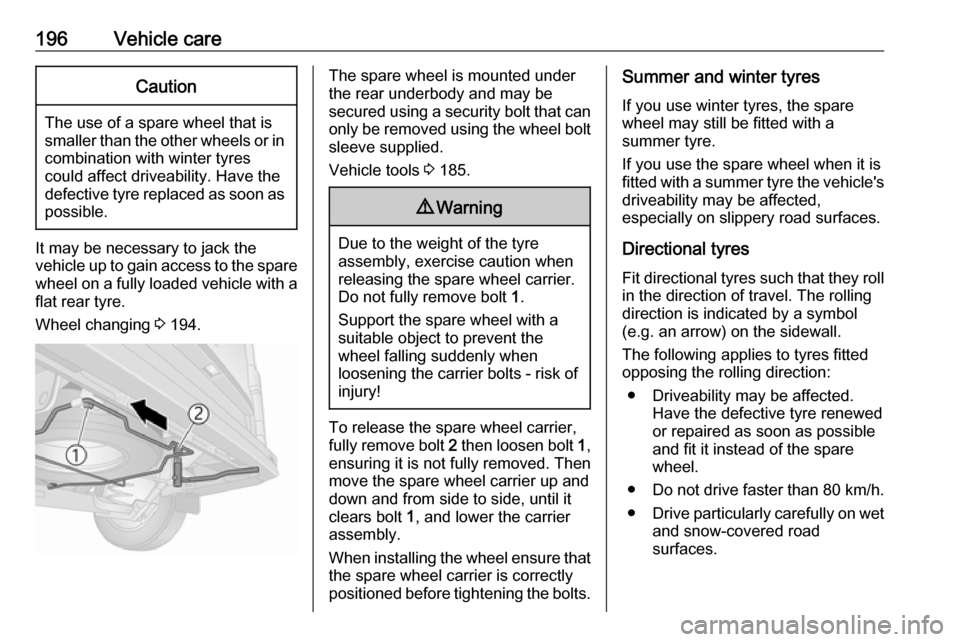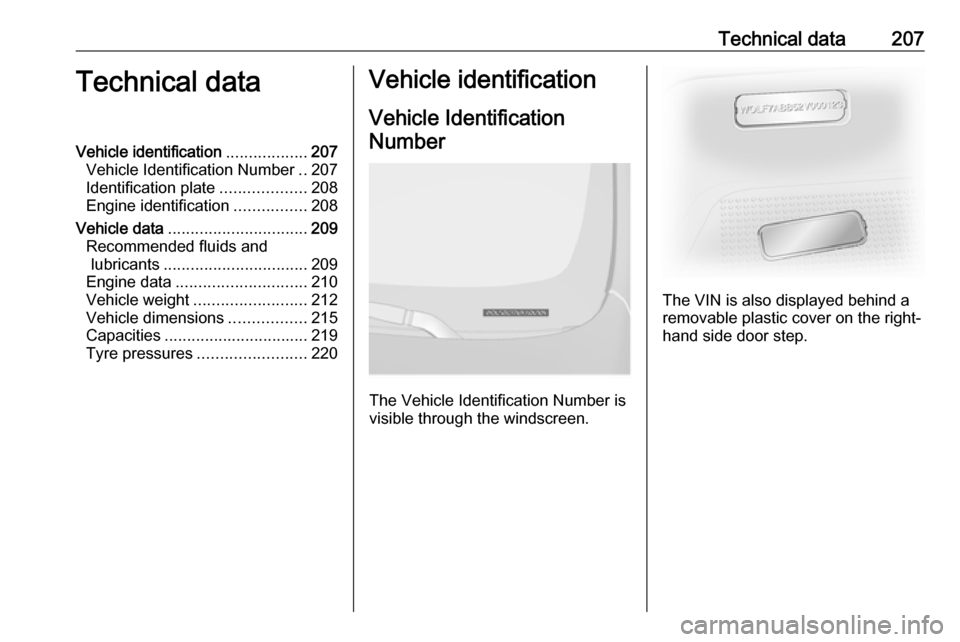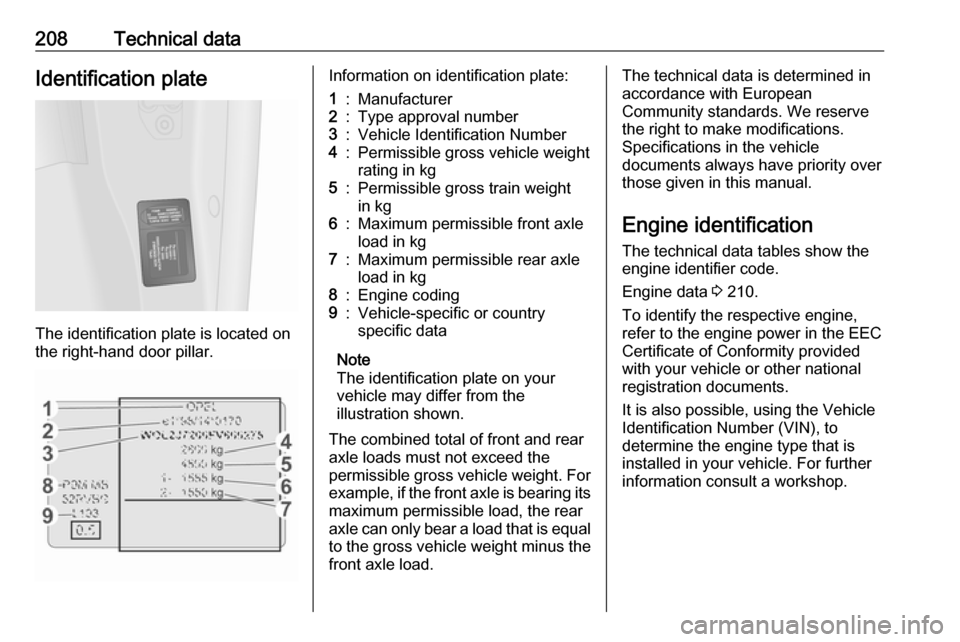weight OPEL VIVARO B 2018 Manual user
[x] Cancel search | Manufacturer: OPEL, Model Year: 2018, Model line: VIVARO B, Model: OPEL VIVARO B 2018Pages: 237, PDF Size: 5.57 MB
Page 164 of 237

162Driving and operatingThe figures are provided only for the
purpose of comparison between different vehicle variants and mustnot be taken as a guarantee for the
actual fuel consumption of a
particular vehicle.
Additional equipment may result in
slightly higher results than the stated
fuel consumption and CO 2 figures.
Furthermore, fuel consumption is dependent on personal driving style
as well as road and traffic conditions.Trailer hitch
General information
Entrust retrofitting of towing
equipment to a workshop. It may be
necessary to make changes that
affect the cooling system, heat
shields or other equipment. Only use
towing equipment that has been
approved for your vehicle.
Driving characteristics and towing tips
In the case of trailers with brakes,
attach the breakaway stopping cable.
Before attaching a trailer, lubricate
the coupling ball. However, do not do so if a stabiliser, which acts on thecoupling ball, is being used to reduce
snaking movements. For trailers with
low driving stability the use of a
stabiliser is recommended.
A maximum speed of 80 km/h must
not be exceeded, even in countries
where higher speeds are permitted.If the trailer starts snaking, drive more slowly, do not attempt to correct the
steering and brake sharply if
necessary.
When driving downhill, drive in the
same gear as if driving uphill and
drive at a similar speed.
Adjust tyre pressure to the value
specified for full load 3 220.
Trailer towing
Trailer loads The permissible trailer loads are
vehicle and engine-dependent
maximum values which must not be
exceeded. The actual trailer load is the difference between the actual
gross weight of the trailer and the
actual coupling socket load with the
trailer coupled.
The permissible trailer loads are
specified in the vehicle documents. In
general, they are valid for gradients
up to max. 12%.
The permitted trailer load applies up
to the specified incline and up to an
altitude of 1000 metres above sea
Page 165 of 237

Driving and operating163level. Since engine power decreases
as altitude increases due to the air
becoming thinner, therefore reducing
climbing ability, the permissible gross
train weight also decreases by 10%
for every 1000 metres of additional
altitude. The gross train weight does
not have to be reduced when driving
on roads with slight inclines (less than
8%, e.g. motorways).
The permissible gross train weight
must not be exceeded. This weight is
specified on the identification plate
3 208.
Vertical coupling load
The vertical coupling load is the load
exerted by the trailer on the coupling
ball. It can be varied by changing the
weight distribution when loading the
trailer.
The maximum permissible vertical
coupling load is specified on the
towing equipment identification plate
and in the vehicle documents. Always aim for the maximum load, especially
in the case of heavy trailers. The
vertical coupling load should never
fall below 25 kg.In the case of trailer loads of
1200 kg or more, the vertical coupling load should not be less than 50 kg.
Rear axle load
When the trailer is coupled and the
towing vehicle fully loaded (including
all occupants), the permissible rear
axle load (see identification plate or
vehicle documents) must not be
exceeded.
Trailer stability assist
If the system detects snaking
movements, engine power is reduced
and the vehicle/trailer combination is selectively braked until the snaking
ceases. While the system is working, keep steering wheel as still as
possible.
Trailer stability assist (TSA) is a
function of the Electronic Stability
Program (ESP® Plus
) 3 150.
Page 188 of 237

186Vehicle careWheels and tyres
Tyre condition, wheel condition Drive over edges slowly and at right
angles if possible. Driving over sharp
edges can cause tyre and wheel
damage. Do not trap tyres on the kerb when parking.
Regularly check the wheels for
damage. Seek the assistance of a
workshop in the event of damage or
unusual wear.
We recommend not swapping the
front wheels with the rear wheels and
vice versa, as this can affect vehicle
stability. Always use less worn tyres
on the rear axle.
Tyres
Factory-fitted tyres are matched to
the chassis and offer optimum driving comfort and safety.Winter tyres
Winter tyres improve driving safety at temperatures below 7 °C and should
therefore be fitted on all wheels.
In accordance with country-specific
regulations, a notice indicating the
maximum permissible speed for the
tyres must be affixed within the
driver's field of vision.
Tyre designations
E.g. 195/65 R 16 C 88 Q195:Tyre width, mm65:Cross-section ratio (tyre height
to tyre width), %R:Belt type: RadialRF:Type: RunFlat16:Wheel diameter, inchesC:Cargo or commercial use88:Load index e.g. 88 is
equivalent to 567 kgQ:Speed code letter
Speed code letter:
Q:up to 160 km/hS:up to 180 km/hT:up to 190 km/hH:up to 210 km/hV:up to 240 km/hW:up to 270 km/h
Choose a tyre appropriate for the
maximum speed of your vehicle.
The maximum speed is achievable at kerb weight with driver (75 kg) plus
125 kg payload. Optional equipment
could reduce the maximum speed of
the vehicle.
Directional tyres
Fit directional tyres such that they roll in the direction of travel. The rolling
direction is indicated by a symbol
(e.g. an arrow) on the sidewall.
Tyre pressure
Check the pressure of cold tyres at
least every 14 days and before any
long journey. Do not forget the spare
wheel. This also applies to vehicles
with tyre pressure monitoring system.
Page 198 of 237

196Vehicle careCaution
The use of a spare wheel that issmaller than the other wheels or in combination with winter tyres
could affect driveability. Have the defective tyre replaced as soon as
possible.
It may be necessary to jack the
vehicle up to gain access to the spare
wheel on a fully loaded vehicle with a
flat rear tyre.
Wheel changing 3 194.
The spare wheel is mounted under
the rear underbody and may be
secured using a security bolt that can
only be removed using the wheel bolt sleeve supplied.
Vehicle tools 3 185.9 Warning
Due to the weight of the tyre
assembly, exercise caution when
releasing the spare wheel carrier.
Do not fully remove bolt 1.
Support the spare wheel with a
suitable object to prevent the
wheel falling suddenly when
loosening the carrier bolts - risk of injury!
To release the spare wheel carrier,fully remove bolt 2 then loosen bolt 1,
ensuring it is not fully removed. Then
move the spare wheel carrier up and
down and from side to side, until it
clears bolt 1, and lower the carrier
assembly.
When installing the wheel ensure that
the spare wheel carrier is correctly
positioned before tightening the bolts.
Summer and winter tyres
If you use winter tyres, the spare
wheel may still be fitted with a
summer tyre.
If you use the spare wheel when it is
fitted with a summer tyre the vehicle's driveability may be affected,
especially on slippery road surfaces.
Directional tyres
Fit directional tyres such that they roll in the direction of travel. The rolling
direction is indicated by a symbol
(e.g. an arrow) on the sidewall.
The following applies to tyres fitted
opposing the rolling direction:
● Driveability may be affected. Have the defective tyre renewed
or repaired as soon as possible
and fit it instead of the spare
wheel.
● Do not drive faster than 80 km/h.
● Drive particularly carefully on wet
and snow-covered road
surfaces.
Page 209 of 237

Technical data207Technical dataVehicle identification..................207
Vehicle Identification Number ..207
Identification plate ...................208
Engine identification ................208
Vehicle data ............................... 209
Recommended fluids and lubricants ................................ 209
Engine data ............................. 210
Vehicle weight ......................... 212
Vehicle dimensions .................215
Capacities ................................ 219
Tyre pressures ........................ 220Vehicle identification
Vehicle IdentificationNumber
The Vehicle Identification Number is
visible through the windscreen.
The VIN is also displayed behind a
removable plastic cover on the right-
hand side door step.
Page 210 of 237

208Technical dataIdentification plate
The identification plate is located on
the right-hand door pillar.
Information on identification plate:1:Manufacturer2:Type approval number3:Vehicle Identification Number4:Permissible gross vehicle weight
rating in kg5:Permissible gross train weight
in kg6:Maximum permissible front axle
load in kg7:Maximum permissible rear axle
load in kg8:Engine coding9:Vehicle-specific or country
specific data
Note
The identification plate on your
vehicle may differ from the
illustration shown.
The combined total of front and rear
axle loads must not exceed the
permissible gross vehicle weight. For
example, if the front axle is bearing its
maximum permissible load, the rear
axle can only bear a load that is equal
to the gross vehicle weight minus the front axle load.
The technical data is determined in
accordance with European
Community standards. We reserve
the right to make modifications.
Specifications in the vehicle
documents always have priority over
those given in this manual.
Engine identification
The technical data tables show the
engine identifier code.
Engine data 3 210.
To identify the respective engine,
refer to the engine power in the EEC
Certificate of Conformity provided
with your vehicle or other national
registration documents.
It is also possible, using the Vehicle
Identification Number (VIN), to
determine the engine type that is
installed in your vehicle. For further
information consult a workshop.
Page 214 of 237

212Technical dataVehicle weight
Kerb weight, basic model Optional equipment and accessories increase the kerb weight.
Loading information 3 82.ModelEngineWheelbaseRoofPayload Class
Gross Vehicle Weight rating
[kg]Kerb weight 4)5)
[kg]VanR9ML1H1100027001661120029001661H2120029001760-1771L2H1120029001691-1695H21200290017754) Kerb weight and gross vehicle weight increase on models fitted with bad road equipment package - refer to identification plate on the
right-hand door pillar.
5) Minimum vehicle weight according to operating permit, including all fluids, vehicle tools and a 90% fuel load. Excludes the weight of
the driver and deletable options, e.g. spare wheel, bulkhead and sliding side load door. Final weight may vary according to the
specification of the vehicle, e.g. options, deleted options and accessories.
Page 215 of 237
![OPEL VIVARO B 2018 Manual user Technical data213
ModelEngineWheelbaseRoofPayload Class
Gross Vehicle Weight rating
[kg]Kerb weight 4)5)
[kg]CombiR9ML1H1100027001901120029001901L2H11200290019014) Kerb weight and gross vehicle weight OPEL VIVARO B 2018 Manual user Technical data213
ModelEngineWheelbaseRoofPayload Class
Gross Vehicle Weight rating
[kg]Kerb weight 4)5)
[kg]CombiR9ML1H1100027001901120029001901L2H11200290019014) Kerb weight and gross vehicle weight](/img/37/18916/w960_18916-214.png)
Technical data213
ModelEngineWheelbaseRoofPayload Class
Gross Vehicle Weight rating
[kg]Kerb weight 4)5)
[kg]CombiR9ML1H1100027001901120029001901L2H11200290019014) Kerb weight and gross vehicle weight increase on models fitted with bad road equipment package - refer to identification plate on the
right-hand door pillar.
5) Minimum vehicle weight according to operating permit, including all fluids, vehicle tools and a 90% fuel load. Excludes the weight of
the driver and deletable options, e.g. spare wheel, bulkhead and sliding side load door. Final weight may vary according to the
specification of the vehicle, e.g. options, deleted options and accessories.
ModelEngineWheelbaseRoofPayload Class
Gross Vehicle Weight rating
[kg]Kerb weight 4)5)
[kg]Platform cabR9ML2H11200290015504) Kerb weight and gross vehicle weight increase on models fitted with bad road equipment package - refer to identification plate on the
right-hand door pillar.
5) Minimum vehicle weight according to operating permit, including all fluids, vehicle tools and a 90% fuel load. Excludes the weight of
the driver and deletable options, e.g. spare wheel, bulkhead and sliding side load door. Final weight may vary according to the
specification of the vehicle, e.g. options, deleted options and accessories.
Page 216 of 237
![OPEL VIVARO B 2018 Manual user 214Technical data
ModelEngineWheelbaseTrim level
Additional minimum weights (approx.)6)
[kg]Front axleRear axleTotalDouble cabR9ML1Base246185Mid276996Upper3278110L2Base315485Mid356196Upper41691106) Fi OPEL VIVARO B 2018 Manual user 214Technical data
ModelEngineWheelbaseTrim level
Additional minimum weights (approx.)6)
[kg]Front axleRear axleTotalDouble cabR9ML1Base246185Mid276996Upper3278110L2Base315485Mid356196Upper41691106) Fi](/img/37/18916/w960_18916-215.png)
214Technical data
ModelEngineWheelbaseTrim level
Additional minimum weights (approx.)6)
[kg]Front axleRear axleTotalDouble cabR9ML1Base246185Mid276996Upper3278110L2Base315485Mid356196Upper41691106) Final weight may vary according to the specification of the vehicle, e.g. options, deleted options and accessories. Refer to identification
plate on the right-hand door pillar.
Page 235 of 237

233Tyre designations ......................186
Tyre pressure ............................ 186
Tyre pressure monitoring system ............................. 100, 188
Tyre pressures ........................... 220
Tyre repair kit ............................. 191
Tyres .......................................... 186
Tyres and wheel size, changing. 190
U Ultrasonic parking assist............. 155
Underseat storage .......................76
Upholstery .................................. 202
Upshift .......................................... 99
USB socket ................................... 88
Using this manual ..........................3
V Vehicle battery ...................171, 197
Vehicle checks............................ 166
Vehicle data ................................ 209
Vehicle data recording and privacy ..................................... 225
Vehicle dimensions .................... 215
Vehicle Identification Number ....207
Vehicle jack ................................ 185
Vehicle messages .....................103
Vehicle security ............................ 37
Vehicle shutdown ......................135
Vehicle specific data ......................3
Vehicle storage ........................... 165Vehicle tools....................... 185, 198
Vehicle unlocking ........................... 6 Vehicle weight ........................... 212
Ventilation ................................... 116
W
Warning chimes .........................104
Warning lights ............................... 91
Warning messages .....................103
Warning triangle .......................... 82
Washer and wiper systems .........16
Washer fluid ............................... 170
Washing the vehicle ...................200
Welcome lighting ........................114
Wheel changing .........................194
Wheel cover hook .......................185
Wheel covers ............................. 190
Wheels and tyres .......................186
Wheel wrench ............................. 185
Wide view mirror ........................... 42
Windows ....................................... 43
Windscreen................................... 43
Windscreen stickers .....................43
Windscreen wiper/washer ...........86
Winter tyres ............................... 186
Wiper blade replacement ..........174